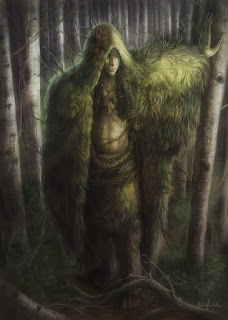Cailleach Bheur
Irish & Scottish for Divine Hag or Creatrix.
Carman (Carmun) was said to be a malevolent warrior-woman, a witch of evil magic, and a goddess in Celtic lore. In Irish mythology she is portrayed as a Greek warrior-woman and sorceress from Athens who tried to invade Ireland in the days of the Tuatha Dé Danann.
This destructive witch traveled with her three evil sons: Dub (“darkness / black”), Dother (“evil / wicked”) and Dain (“violence / fierce”), destroying anything or anyone in their path and ravaging Ireland.
Carman used her magical powers to put a blight on Ireland’s crops and terrorized the Irish until four of the Tuatha De Danann, the “peoples of the goddess Danu,” Crichinbel, Lug, Bé Chuille and Aoi, challenged Carman and her sons and used their superior magic to fight and defeat her.
The sons were forced to leave Ireland and were banished across the sea. Carman was imprisoned. Her story is told in a poem of the Metrical Dindshenchas, which states that she died in 600 BCE. She died of longing and was buried in Wexford among oak trees. Her grave was dug by Bres. The place she was buried was called Carman after her, and the Tuatha Dé Danann are said to have instituted an Óenach, or festival. The Óenach Carman, which was celebrated at the beginning of August during historical times.
Modern legend portrays Carman as a Goddess of black magick, one who can destroy anything by thrice chanting a spell. This is also the way that the Morrigu, particularly Badb, can destroy. However, this is not a manifestation of evil intent, but an end of the world prophecy common to many cultures. It is believed she has roots in the Greek grain Goddess, Demeter.
An Excerpt of Carmun from The Metrical Dindshenchas
Carmun
Hearken, ye Leinstermen of the graves,
O host that rule Raigne of hallowed rights,
till ye get from me, gathered on every hand,
the fair legend of Carmun high in fame!
5] Carmun, gathering place of a hospitable fair,
with level sward for courses: —
the hosts that used to come to its celebration
conquered in its bright races.
A burial-ground of kings is its noble cemetery,
10] even specially dear to hosts of high rank;
under the mounds of assembly are many
of its host of a stock ever-honoured.
To bewail queens and kings,
to lament revenges and ill deeds,
15] there came many a fair host at harvest-time
across the noble lean cheek of ancient Carmun.
Was it men, or a man of mighty prowess,
or woman with passionate emulation,
that won a title of
[...]
without disrepute ,
20] and gave its proper name to noble Carmun?
Not men it was, nor wrathful man,
but one fierce marauding woman —
bright was her precinct and her fame —
from whom Carmun got its name at the first.
25] Carmun, wife of the son of fierce Dibad,
son of right hospitable Doirche of the hosts,
son of Ancgeis rich in substance,
was a leader with experience in many battles.
No supply of gain appeased them
30] in their ardent desire for noble Banba;
because they were distressed perpetually in the East,
the children of the son of Dibad and their mother.
They fared westward for the second time
— Dian and Dub and Dothur, —
35] from the East out of distant Athens,
they and Carmun their mother.
In the borders of the Tuatha De
the folk of a hostile wedlock ravaged
the fruit of every land to the shore:
40] it was a dreadful lawless pillage.
Carmun, by means of every spell of fame,
destroyed all sap of swelling fruit,
after strife waged with all arts unlawful,
and the sons through battle and lawlessness.
45] Then the Tuatha De perceived them;
horror and hideousness betrayed them
for every cruel deed they did,
the Tuatha De inflicted the like number upon them.
Crichinbel — no deception this!
50] and Lug Laebach son of Cacher
Be Chuilli into which I shall go above all battlefields
and Ai son of Ollam,
The stern four, equal-strong,
said to them on overtaking them,
55] "A woman is here to match your mother,
three men to the brothers three;
"Death to you — no choice ye would choose,
no blessing, no lucky wish!
or else leave with good grace a hostage;
60] depart from Erin ye three only!"
Those men departed from us;
stern means were found to expel them;
though it seemed distant to them, they leave here
Carmun — alive in her narrow cell.
65] Every pledge was given that is not transgressed with safety,
the sea with its beasts, heaven, earth with its bright array,
that the strong chiefs should not come southward
so long as the sea should be round Erin.
Carmun, death and yearning carried her off.
70] increase of mourning visited her
she found her fate, as was right,
among the oaks of the strong graves.
Thither came, for the delight of her beauty,
to keen and raise the first wailing over her,
75] the Tuath De over this noble plain eastward:
it was to the first true fair of Carmun.
The grave of Carmun, who digged it?
do ye learn, or do ye know?
according to the judgment of every esteemed elder















